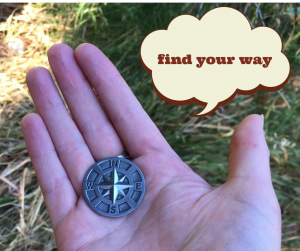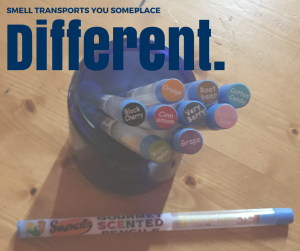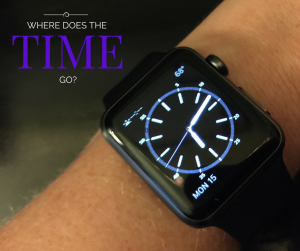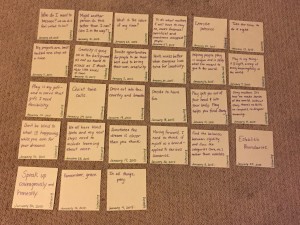by Naomi | Jul 3, 2015 | Tools & Apps
 Object:
Object: Setting realistic expectations for my drive time, and avoiding traffic whenever possible. Also, making my drive-time productive thinking or learning time rather than stressed-out finding-my-way time.
What Didn’t Work: Relying on my favorite back-road route only to find that today that route was clogged with construction traffic. Planning to be to a client in half an hour, only to find that today, an accident had caused a twenty minute delay. Spending my whole drive stressed out and blindly trying other routes instead of being able to relax and spend the time thinking about projects or learning from podcasts or escaping into a story audiobook-style.
My Aha! Moment: I have a strong internal compass, so it took me a long time to give in and let Waze take the lead. But, after enough frustration, and a few unexpected late arrivals for clients, I decided to rely on Waze and its ability to calculate drive-time in real-time. Now, I can text my clients and let them know if the drive may take longer than planned.
- I use a suction cup mount for my phone in my car, so I can see Waze safely as I drive.
- I’ve made it a habit to start up Waze whenever I’m on my way somewhere and time is an issue. I don’t navigate on errands or other more meandering trips, but my husband hopes that my habit will evolve. He uses Waze for nearly every trip we take out of the neighborhood.
- I email or text myself the address of new places I’m headed, so I can easily paste the location into the Waze search. That said, the search function on the app is powerful, and public places are usually simple to locate inside the app itself.
- As long as traffic seems normal, I turn off the app about ten minutes from home. I don’t need all the last turn-by-turn instructions, and that way I can listen to my audiobook or podcast in peace.
Take it to the Next Level:
- I’m trying out TripLog, too, to track business mileage. Since I start up Waze for each drive, it’s just one more step to also start TripLog. Maybe TripLog will make the playlist sometime soon.
by Naomi | Jun 26, 2015 | Tools & Apps
 Object:
Object: Reminding myself to play a little in the middle of a busy work-day.
What Didn’t Work: Telling myself to lighten up. Brow-beating myself when I got to the end of the day and realized I hadn’t even taken even two minutes to have fun… major fail on the play front. Was I a hypocrite, preaching play yet never doing it myself?
My Aha! Moment: My mom gave me a set of Smencils for Christmas. There’s something about smell that touches your heart and transports you someplace different. Just try to write with a root-beer scented pencil and stay in a no-nonsense mood.
- I keep my smencils on my desk and pull one out every now and again when I need to brainstorm and would like to add a little play to the process.
- Keep your smencils in their containers, so they maintain their scents as long as possible.
Take it to the Next Level:
- Bring out your smencils for your next team meeting or one-on-one session. Let your colleagues or students in on the fun, and add some whimsy to your time together.
by Naomi | Jun 19, 2015 | Tools & Apps
 Object:
Object: Understanding how my time is spent, to gain a big picture view (and if needed, adjust) my work-habits.
What Didn’t Work: Trying to put things on the calendar and stick to strict pre-determined time slots. Hopping from one project to another in response to whatever pinged at the moment. Simply hoping I was getting to all of my projects. Only vaguely being able to answer the question: so how long did it take to… (fill in the blank)?
My Aha! Moment: I was listening to Amy Porterfield’s podcast (
Episode 47). In this interesting interview about mindset she interviewed Todd Herman. Todd suggested keeping a chart of $10 work, $100 work, and $1000 work for a week. The challenge was to notice each task you did and record it into one of those columns. I loved the idea of the activity, but wasn’t yet in the place where I could afford to outsource anything. Outsourcing is the ultimate goal of the activity— acknowledging that when you’re the content-maker, creating your content is your greatest contribution, and that perhaps you oughtn’t to be coding HTML so your website works.
I remember thinking, “But I don’t even know which projects I’m spending my time on, let alone the amount of money I’d someday be able to pay someone to do the tasks!” For me, the first problem to tackle was “which project does this task fit into?” I needed to better understand where my hours were going before I could determine where any time-leaks might be. Maybe I was spending 20 hours a week on a project, but on all of the wrong parts of the project. Or maybe I was ignoring certain projects for too long, only returning to them after they had turned into raging problem-fires. I needed a way to track my time.
Enter the
Timely app, a very nice-to-look-at visual time-tracking tool.
- I’ve connected the Timely app with my main calendar, so the app knows what I’m supposed to spend my time on.
- I can create a new task with just a couple easy clicks on my phone or desktop, and start a timer or enter time spent manually.
- I use big categories, such as “admin” or “planning,” and sometimes add a few notes. The main thing for me is to see what I’m doing in broad strokes.
Player’s Notes:
- If my day gets busy and I forget to record some time spent, I record estimates at the end of the day, when I still remember.
- Timely has saved me so much time going back and trying to remember, particularly with invoices. Often, scheduling and hourly billing shifts due to various factors, so having a day-by-day record what actually happened is very helpful.
Take it to the Next Level:
- Review how your time was spent every couple weeks with the Timely reports. Are there trends that point to problems? If so, how can you turn that problem into a question, for which you can then seek a solution?
by Naomi | Feb 4, 2015 | Creative Life
 What’s so frightening? What’s causing me to halt in my tracks and ask myself if I really want to accept the call, after all?
What’s so frightening? What’s causing me to halt in my tracks and ask myself if I really want to accept the call, after all?
It’s this bothersome set of questions which should have simple answers, but when considered honestly, have the power to block me entirely.
What questions?
Will I, or will I not, dare to put my heart on the line–literally–put my passion for letting play into my creative process online for all to see? Do I, or do I not, believe that learning to play, and thus, Writerly Play, will transform writers’ lives? Am I, or am I not, willing to share my ups and downs as I continue to learn to dive in and play, myself? Will I commit to show up regularly online? Do I believe in this message enough to invest time, effort and courage in sharing it?
Here’s what I realized, looking at my cards from this past month. I’ve been dabbling. I’ve been cramming Writerly Play, and what I feel I’m supposed to work on creatively into the nooks and crannies of my life. And those nooks and crannies continue to shrink, and shrink and shrink. Life calls, after all. Someone asks me to take on a quick consulting gig. Someone else asks me to add a project to my list. I’m getting paid–and asked directly for–what others see I’m capable of doing. This isn’t their fault, not one bit. I haven’t shown them what’s deeper. I haven’t shared, truly, my vision. I’ve got it all bottled up inside of me and I keep hoping and wishing and dreaming…
So, today, I’m headed out to toss my coin into Los Gatos Creek, and then I’m coming home to start spreading the news about Writerly Play–and to face all the fears and challenges that go hand in hand with that journey. I’m committing to dive in and dive deep–for real this time. Even when I doubt that anyone is listening, I’ll keep the vision in mind and keep writing, keep creating. Most importantly, I’ll keep playing, even when play seems like the least important thing on my list. Because that’s the thing about the most important things in our lives–they’re not the ones that shout for our attention. And yet they need our attention most of all.
by Naomi | Feb 3, 2015 | Creative Life
 As I’ve been working through my hero’s journey process, I’ve been reading The Writer’s Journey by Christopher Vogler. After the chapter on the Call to Adventure, there’s a chapter on Refusing the Call, which I assumed I’d skip. Since I set this process out for myself ahead of time, I knew it would feel false to purposely “refuse the call.” Obviously, I planned to accept the adventure. I committed to taking the journey when I created my travelogue journal and bought the coins for each stage and found the hollow book in which to put my daily notes.
As I’ve been working through my hero’s journey process, I’ve been reading The Writer’s Journey by Christopher Vogler. After the chapter on the Call to Adventure, there’s a chapter on Refusing the Call, which I assumed I’d skip. Since I set this process out for myself ahead of time, I knew it would feel false to purposely “refuse the call.” Obviously, I planned to accept the adventure. I committed to taking the journey when I created my travelogue journal and bought the coins for each stage and found the hollow book in which to put my daily notes.
But low and behold, a surprise! I shouldn’t have been surprised, given the fact that no one has ever heard of a simple hero’s journey. The point of setting out was to tackle something challenging, to grow personally and creatively, to wrestle those parts of myself that derail me and get in my way. A hero’s journey stretches a traveler’s courage, patience and hope. Often, a hero’s journey leads a traveler to the brink of despair.
In fact, this epic nature of a hero’s journey was the reason I wasn’t sure setting the process up for myself ahead of time would work. How could I be sure I’d face something authentically challenging? If I knew ahead of time I was headed to a difficult place, wouldn’t I avoid the worst of it or act as thought I were facing a true challenge when in point of fact it was more of a speed bump?
Nope. Turns out there is plenty of room for surprise.
On Saturday, I took out my cards from this past month and laid them all out on the floor. These cards, in case you haven’t read about them before, are notes I’ve been writing, one per day, on a key thought or discovery from the day. They read with sentences and phrases such as “Big projects are best tackled one step at a time,” or “Exercise patience,” or “Story matters. It’s how we make sense of the world…” I organized my notes and found that they became a sort of narrative that flowed one thought to the other. Rather than flowing in a chronological order from day to day, re-ordered, the cards made a kaleidoscopic picture of where my mind has traveled, and gave me a sense (which I couldn’t have otherwise articulated) of what the call to adventure truly is, right now, in my life.
And once I realized what the call was, I thought I’d simply move forward. I’d already planned to toss my coin into water to cross from one stage of the journey to the next, so all I needed to do was to go out and do it. But, that was when I stalled out. All day, I had a myriad of excuses. Maybe I’d do it tomorrow.
On Sunday, it was the same. Maybe tomorrow.
Monday? Yep, you’ve got it. Total avoidance.
So, I read the chapter on refusing the call, and my reaction (and resistance) started to make more sense. I’ll tell you more about it tomorrow.
 Object: Setting realistic expectations for my drive time, and avoiding traffic whenever possible. Also, making my drive-time productive thinking or learning time rather than stressed-out finding-my-way time.
Object: Setting realistic expectations for my drive time, and avoiding traffic whenever possible. Also, making my drive-time productive thinking or learning time rather than stressed-out finding-my-way time.



